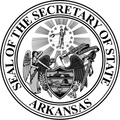| Secretary of State of Arkansas | |
|---|---|
 Seal of the secretary of state | |
since January 1, 2025 | |
| Style | Mr. Secretary (informal) The Honorable (formal) |
| Seat | State Capitol, Little Rock, Arkansas |
| Term length | Four years, renewable once (Seventy-third Amendment to the Arkansas Constitution of 1874) |
| Constituting instrument | Arkansas Constitution of 1836 |
| Precursor | Secretary of Arkansas Territory |
| Formation | September 16, 1836 |
| First holder | Robert A. Watkins |
| Salary | $54,305 [1] |
| Website | sos |
The Arkansas Secretary of State is one of the elected constitutional officers of the U.S. State of Arkansas.
Contents
The current Secretary of State is Republican Cole Jester who was appointed by Governor Sarah Huckabee Sanders after John Thurston became the state treasurer.